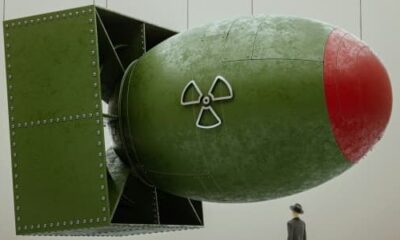Science
Everyday Technologies Revolutionized by Military Research

Military research has played a pivotal role in shaping technologies that have become integral to daily life. Numerous inventions, originally developed for defense purposes, have found widespread civilian applications, demonstrating the far-reaching impact of military innovation. Recognizing these origins provides valuable insight into how military advancements influence modern living.
Transformative Technologies with Military Roots
Several technologies originating from military projects have evolved into essential tools for everyday use. Here are ten significant examples:
1. **Global Positioning System (GPS)**: Initially developed by the U.S. military during the Cold War for precise navigation and logistics, GPS is now crucial for civilian navigation and location-based services worldwide. Its evolution stems directly from military research aimed at improving operational accuracy on the battlefield.
2. **The Internet**: The internet’s foundation lies in ARPANET, a project initiated by the U.S. Department of Defense. This decentralized communication network was designed to withstand outages. Today, it supports global information exchange, e-commerce, and digital communication, transforming how society interacts.
3. **Digital Photography**: Originally created for reconnaissance through spy satellites, digital camera technology has advanced to become commonplace in smartphones and social media, revolutionizing how people capture and share images.
4. **Radar Technology**: Developed during World War II to detect enemy aircraft, radar is now integral to air traffic control, weather forecasting, and automotive safety systems. This technology showcases the transition from military to civilian applications.
5. **Night Vision**: Designed for low-light combat scenarios, night vision technology has found uses in law enforcement, search and rescue operations, and wildlife observation, extending its benefits beyond military personnel.
6. **Microwave Oven**: The microwave oven was born from an accidental discovery during radar research when a candy bar melted near microwave equipment. This innovation has since made cooking faster and more efficient, becoming a staple in households worldwide.
7. **Duct Tape**: Created during World War II for sealing ammunition cases, duct tape has evolved into a versatile household item used for repairs and emergency fixes, demonstrating how military materials can find broader applications.
8. **Jet Engine Technology**: Jet engines originally powered military aircraft and have since been adapted for commercial aviation, revolutionizing air travel by enhancing speed and efficiency.
9. **Nuclear Technology**: Emerging from the Manhattan Project, nuclear technology has transitioned from weapon development to applications in energy production and medical treatments, such as radiation therapy.
10. **Sanitary Products**: Military medical research during World War I led to advancements in bandage materials and sanitary products. These innovations have significantly improved hygiene and women’s health products in civilian life.
The Broader Impact of Military Innovations
Military laboratories were instrumental in the early development of computers, designed to perform complex calculations for artillery targeting and codebreaking. These innovations laid the groundwork for modern computing, software development, and the digital age we experience today.
The transition of military technologies into civilian life often stems from addressing urgent challenges. Once proven effective, these technologies are adapted for civilian use due to demand and economic potential. This “trickle-down” effect illustrates how innovations can migrate from the battlefield to everyday scenarios, fostering new industries and conveniences.
The widespread adoption of technologies developed from military research highlights a significant narrative in the history of everyday technology: investments in defense can lead to breakthroughs that benefit society at large. These advancements improve communication, safety, healthcare, and transportation, linking the legacy of military innovation with modern civilization.
Adapting military technologies for civilian applications can present challenges. Issues such as meeting legal and ethical standards and ensuring responsible use are critical. Moreover, the differences in organizational culture and market dynamics between military and civilian sectors can create resistance to innovation.
Ethical considerations are paramount in the development of military technologies, particularly regarding dual-use technologies that may impact civilian populations. Balancing military advantages with minimizing potential harm is essential. The need for careful regulation and oversight is underscored by the risks associated with the blurring of military and civilian domains.
In conclusion, the impact of military-origin technologies is profound. They shape global security and influence warfare capabilities while also enhancing daily life. Understanding their origins and adaptations underscores the importance of responsible innovation and thoughtful integration into civilian contexts.
-

 Entertainment3 months ago
Entertainment3 months agoAnn Ming Reflects on ITV’s ‘I Fought the Law’ Drama
-

 Entertainment4 months ago
Entertainment4 months agoKate Garraway Sells £2 Million Home Amid Financial Struggles
-

 Health3 months ago
Health3 months agoKatie Price Faces New Health Concerns After Cancer Symptoms Resurface
-

 Entertainment3 months ago
Entertainment3 months agoCoronation Street’s Carl Webster Faces Trouble with New Affairs
-

 Entertainment3 months ago
Entertainment3 months agoWhere is Tinder Swindler Simon Leviev? Latest Updates Revealed
-

 Entertainment4 months ago
Entertainment4 months agoMarkiplier Addresses AI Controversy During Livestream Response
-

 Science1 month ago
Science1 month agoBrian Cox Addresses Claims of Alien Probe in 3I/ATLAS Discovery
-

 Health4 months ago
Health4 months agoCarol Vorderman Reflects on Health Scare and Family Support
-

 Entertainment4 months ago
Entertainment4 months agoKim Cattrall Posts Cryptic Message After HBO’s Sequel Cancellation
-

 World2 weeks ago
World2 weeks agoBailey Announces Heartbreaking Split from Rebecca After Reunion
-

 Entertainment3 months ago
Entertainment3 months agoOlivia Attwood Opens Up About Fallout with Former Best Friend
-

 Entertainment2 weeks ago
Entertainment2 weeks agoCoronation Street Fans React as Todd Faces Heartbreaking Choice



















